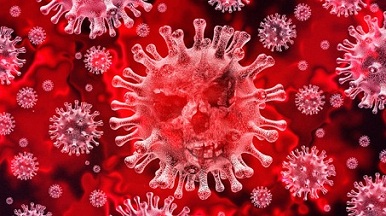BREAKING! UK AND German Scientists Discover That Protein LRRC15 Interaction With SARS-CoV-2 Spike Protein Could Be Modulating Infection!
Source: SARS-CoV-2-LRRC15 Oct 03, 2021 4 years, 2 months, 2 weeks, 3 days, 14 hours, 15 minutes ago
SARS-CoV-2 and LRRC15: A new study by researchers from Wellcome Sanger Institute-UK, University of Cambridge-UK, Leibniz Institute for Primate Research-Germany, Georg-August University Göttingen-Germany and University of York has revealed that the protein called LRRC15 (Leucine-rich repeat containing 15) gene previously unknown to be involved in SARS-CoV-2 infection, is seen to interact with the spike proteins of the SARS-CoV-2 and could be possibility be modulating infection!

The study team presented evidence from genome-wide screening that the spike protein of SARS-CoV-2 interacts with human host cells expressing LRRC15. The interaction is distinct from previously known classes of spike attachment factors, and appears to have emerged recently within the coronavirus family. Although not sufficient for cell invasion, this interaction can modulate viral infection.
The study findings point to an unappreciated host factor for SARS-CoV-2, with potential relevance to COVID-19.
The study findings were published on a preprint server and are currently being peer reviewed
https://www.biorxiv.org/content/10.1101/2021.09.25.461776v1
In the initial stages of the pandemic, it was discovered that the SARS-CoV-2 coronavirus binds to the ACE2 receptors of the host in order to have initial cell incision.
However as many organs and tissues in the human host did not contain these ACE2 receptors especially the human lungs but were still badly affected by the novel coronavirus, many scientist turned towards identifying other receptors or human host proteins that the SARS-CoV-2 could use to enter the host cells.
Another recent study found that the SARS-CoV-2 could also bind to numerous other receptors in the human host besides the ACE2 receptors to gain entry into human cells and tissues.
https://www.thailandmedical.news/news/breaking-worrisome-study-findings-reveal-that-sars-cov-2-variants-spike-proteins-can-bind-to-more-than-13-other-host-receptors-besides-ace2
These new study findings provide evidence for a novel mechanism by which SARS-CoV-2, the pathogen that causes the COVID-19 disease, binds to human host cells.
The
SARS-CoV-2-LRRC15 study team found that in addition to the host cell receptor angiotensin-converting enzyme 2 (ACE2), the spike protein of SARS-CoV-2 also binds to a protein encoded by the LRRC15 (leucine-rich repeat containing 15) gene.
Leucine rich repeat containing 15 is a protein that in humans is encoded by the LRRC15 gene. LRRC15 is a novel mesenchymal protein and stromal target for antibody-drug conjugates.
https://cancerres.aacrjournals.org/content/78/14/4059
It has also been found to play important roles in cancer.
com/articles/10.1186/s13287-018-0809-1">https://stemcellres.biomedcentral.com/articles/10.1186/s13287-018-0809-1
https://abbviescience.com/oncology/biomarker-pathways/lrrc15
First author Dr Gavin Wright from the Cell Surface Signalling Laboratory, Wellcome Sanger Institute stresses that this interaction is distinct from previously known spike attachment factors and appears to have emerged recently within the coronavirus family.
Although assays showed that while the expression of LRRC15 alone was not sufficient to permit viral entry, its interaction with the spike could modulate infection.
Dr Wright added, “Our data point to an unappreciated host factor for SARS-CoV-2, with potential relevance to COVID-19.”
It must be noted that the binding interactions that occur between SARS-CoV-2 and host cell factors enable the virus to propagate infection that causes COVID-19. The unprecedented virulence and spread of SARS-CoV-2 suggest that the virus has developed particularly effective mechanisms for targeting host cells.
To date, the most prominent structure on the surface of SARS-CoV-2 is the spike protein, which mediates the initial stage of infection when its receptor-binding domain (RBD) attaches to ACE2. This spike is a central component in many of the vaccines and antiviral therapies that have been developed to help prevent or treat COVID-19.
Although the spike protein is already known to bind to ACE2, there is considerable debate regarding whether ACE2 alone is sufficient to explain COVID-19 pathology.
As an important example - certain target cells only express low levels of ACE2 and questions remain over whether additional factors may explain the broad cellular tropism of SARS-CoV-2.
The study team performed two independent cell-based screens of SARS-CoV-2 spike binding to determine whether host proteins other than ACE2 enable the spike to interact with cells.
Interestingly this screening identified LRRC15 expression as a novel additional host factor that promotes spike binding.
Importantly the interaction of spike with LRRC15 was reproducible in different human cell lines and was distinct from other known glycan- or ACE2-binding pathways.
Detailed analysis of related coronavirus spikes revealed that the interaction was restricted to SARS-CoV-2, suggesting that LRRC15 represents a novel class of spike binding interaction.
It was observed that the interaction was located to the C-terminus of the S1 domain of the spike protein and LRRC15 shared recognition of the ACE2 RBD.
Utilizing proteomics and single-cell transcriptomics, the study team found that LRRC15 expression was common in human lung vasculature cells and fibroblasts.
Although infection assays demonstrated that cell surface expression of LRRC15 alone was not sufficient to permit viral entry, the team found evidence that it could modulate host cells’ susceptibility to SARS-CoV-2 infection.
The study team stressed that the spike–LRRC15 interaction “merits urgent further investigation.”
For more about
SARS-CoV-2 and LRRC15, keep on logging to Thailand Medical News.
